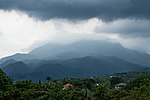Los Baños (IPA: [lɔs bɐˈɲɔs]), officially the Municipality of Los Baños (Tagalog: Bayan ng Los Baños), colloquialy 'elbi' or simply LB, is a 1st class municipality in the province of Laguna, Philippines. According to the 2020 census, it has a population of 115,353 people.It has a total land area of 56.5 square kilometers (21.8 sq mi) and is bordered on the south and south-west by Mount Makiling and Santo Tomas in Batangas, on the north by Laguna de Bay, on the north-west by Calamba and on the east by the town of Bay. The town is located 63 kilometers (39 mi) southeast of Manila and is easily accessible via the South Luzon Expressway along with Manila South Road and Calamba–Pagsanjan Road.
The municipality lies on the northern slopes of the long dormant volcano Mount Makiling and is known among tourists for its hot spring resorts. Los Baños also hosts two constituent universities of the University of the Philippines System: the University of the Philippines Los Baños and University of the Philippines Open University, along with other foreign and local and international research centers, such as the International Rice Research Institute, the ASEAN Center for Biodiversity, the Philippine Rice Research Institute, Philippine Carabao Center at UPLB, and SEAMEO-SEARCA, making the town a temporary home for tens of thousands of both local and foreign undergraduate and graduate students, researchers and support staff.
Los Baños was declared as the Special Science and Nature City of the Philippines through Presidential Proclamation No. 349. The proclamation, however, does not convert the municipality to a city or give it corporate powers that are accorded to other cities.
Aside from its importance in academics, science and research, Los Baños is a well-known tourist destination. Because of the town's proximity to Metro Manila, Los Baños's hot spring resorts are frequent weekend or summer getaways for residents of the vast metropolis and tourists from other places in the Philippines and abroad. Tourists who visit Los Baños also come to the several native delicacies stores in the town to buy the town's famous buko pie (coconut meat pie) as well as a home-grown brand of chocolate cake. Currently, it is Laguna's richest municipality in terms of assets amounting to ₱652.95 million as of 2017.



